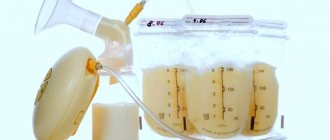Breast milk and the newborn
Some characteristic behavior traits in case of lack of breast milk:
- After the baby has eaten, he begins to cry and tries to find the breast.
- The baby's stool is rare and insignificant.
- The baby suckles for a very long time, however, the age of one week has already been overcome.
If the mother feels a rush of milk, but during feeding everything goes away and the baby immediately falls asleep, then this means that the baby has eaten his quota. In this case, you should not look for any additional measures, including pumping, in order to check the amount of milk that the child has consumed.
It should be recalled that an active flow of milk is observed after seven days after birth. If the baby receives adequate nutrition, he will defecate 1-3 times a day and pee about 6-15 times . Therefore, more than six soaked diapers should add joy to the mother and save her from unnecessary worries.
A newborn baby should eat at a time as much as his body needs. Therefore, when breastfeeding your baby, you should not control the amount you drink if you feel that the baby is full and nothing bothers him. With good feeding, the baby gradually gains weight, plays, grows quite well, etc.
If a mixed feeding system or completely artificial feeding is used to feed the baby, the mother must constantly think about how much milk or formula the baby has eaten. The mother should note that the baby is fed, but he should not overeat at all. Otherwise, he may have stomach problems.
Why does milk disappear?
A decrease in breast milk supply may be due to factors such as:
- Late breastfeeding after childbirth - milk in the breast begins to be produced on the third day, but it is necessary to put the baby to the breast in the first hours of his life, even if it seems that the breast is empty. At this time, colostrum appears in the breast, which the baby also needs, plus breast stimulation occurs, promoting subsequent milk production.
- Pre-breastfeeding - the baby can be fed formula in the maternity hospital. The baby is full, does not want to suck, and does not stimulate the breast.
- Ineffective sucking - If your baby was born weak, he may simply not be able to suck. Also, the cause of ineffective sucking may be a weakened sucking reflex or a specific structure of the oral cavity.
- Incorrect position of the baby at the breast is the most common cause. We will write below about how to apply it correctly.
- Feeding according to a schedule - feeding strictly according to the clock does not take into account the individual characteristics of mother and baby. As a result, the breasts are not stimulated enough, little milk appears, the baby screams, and the mother cries. As a result, many people have a schedule, but their own, individual one.
- The child does NOT release the nipple on his own - limiting the duration of sucking. Some children eat quickly, others eat slowly. There are also those who fall asleep for a short time during feeding; the 20 minutes allotted by their mother is definitely not enough for them. Each child has unique characteristics and does not have to conform to the descriptions in the literature.
- Supplementation - it is not recommended to give water to a breastfeeding baby up to 6 months old; read more about this here.
- Pacifiers, pacifiers - babies have an innate sucking reflex; sucking movements stimulate lactation. If the baby sucks on something else, he may refuse the breast and the milk will gradually decrease. Nipple confusion may occur after bottle feeding. Often babies do not want to breastfeed, because milk flows easily from the bottle and there is no need to make an effort.
- Lack of family support - a woman's milk production is closely related to her emotional state. If she feels the support of her family at home, she is calm and relaxed, then there will be no problems with milk. If she is constantly told “you don’t have enough milk,” the chances of continuing breastfeeding are reduced.
Normal breast milk for a newborn
How many grams of breast milk should a newborn eat?
Let us immediately note that for the first three days the baby eats colostrum. This liquid is quite fatty and nutritious; it contains a lot of useful substances that are necessary for active and normal growth. To ensure that your baby's nutritional needs are met, very little colostrum is enough.
In the first days, the baby eats quite little, but often . There are some reasons for this fact. Such frequent meals are caused by the fact that the newborn’s stomach is not yet fully developed, its volume is no more than 7-9 milliliters, and also because the baby does not yet have special skills in sucking the breast.
Many children's doctors consider it natural that the child refuses his mother's breast for the first few days. After the period of colostrum ends, the newborn begins to eat breast milk. Of course, parents immediately have a question: “How many grams of breast milk should a newborn eat?”
Let us immediately note that the answer to this question may depend on several factors. First of all, the volume of breast milk depends on how much the baby weighs and how tall he is. The volume of one feeding also depends on the age of the baby, as well as the nutrients contained in the mother's milk. One of the most basic criteria for milk is its fat content. It is known that the more the baby weighs and the greater his height, the more he should eat.
A formula that allows you to calculate the rate of breast milk per feeding:
V=10*W, where V is the volume of milk in milliliters, W is the child’s age in days.
The approximate amount of milk that a child should consume per day, depending on age:
| Amount of milk consumed per day (ml) | Age |
| 600 | 1+ month |
| 700 | 2+ months |
| 900 | 6+ months |
| 1050 | 9+ months |
| 1200 | 12+ months |
Note that different sources report slightly different indicators of breast milk norms for babies. This is due to the fact that the information provided comes from different pediatric schools.
How much milk can you express in one procedure?
It all depends on when mommy pumps. If immediately after feeding, you may not get a drop of valuable liquid. The exception is hyperlactation, when there is too much milk.
Immediately before feeding the baby, you can get 50-100 ml. This portion is enough to fully feed your baby with expressed breast milk. Sometimes even before feeding, mothers cannot strain anything - this indicates an incorrect technique.
Milk is expressed especially well at night, since it is at night that prolactin is produced and is responsible for milk production. Therefore, to replenish supplies, it is better to pump between 2 a.m. and 6 a.m.
The reasons for low pumping may be:
- The baby eats all the milk produced.
- Incorrect hand expression technique or poorly selected breast pump.
- Mom is too tense and can't relax.
- The woman neglects to prepare for pumping and does not wait for the tide.
How to determine the amount of milk eaten
First, parents need to determine how many grams of breast milk a newborn should eat, and only after that, they need to calculate the figure that will mean how much the baby consumed. The easiest way to determine how much your baby has eaten is by weighing.
It should be noted that weighing is best done on electronic scales, as they can show accurate results. To do this, you need to weigh the baby before feeding, and then after. The difference that results will indicate the amount of food consumed. The baby should be weighed in the same clothes and, of course, without changing the diaper.
If the baby shows you all the signs of normal condition, in the sense that he is not capricious, he sleeps well, gains weight according to the norms, then the child eats as much as his body requires.
How to feed your baby expressed milk
In order to feed your baby expressed breast milk, it must be heated to a temperature of 36 degrees. If the milk has been in the refrigerator, then it is heated in hot water, in a water bath or in special electric heaters.
Frozen milk must be taken out and placed in the refrigerator so that it takes on a liquid form. After this, it is heated as described above.
Experts do not recommend using microwave ovens to heat milk, as microwaves destroy its structure and destroy many beneficial substances.
During storage, milk may separate into fractions, then before drinking you need to shake the bottle several times, and it will return to its original form.
When milk is taken out of the freezer or refrigerator, it must be used all at once. Remains must be thrown away
Breastfeeding rules
In order for a woman to have normal lactation, two points are important here, namely:
- correct attachment of the baby to the breast
- organization of proper feeding
You need to know that the volume consumed at one time is not important. Attention should be paid to how much the baby eats per day. The baby's condition depends on how much he eats.
It is imperative to provide the baby with not only primary milk, but also later milk, as is known, it is more healthy and has a higher percentage of fat content . Therefore, late milk is very healthy and nutritious. To achieve this, it is necessary to ensure that the baby sucks the entire breast, since milk later enters the breast after the baby has intensively sucked regular milk, after about 10-15 minutes.
Note that a newborn should not be denied breastfeeding at night, since an intense flow of milk occurs precisely during this period . If feeding is organized completely incorrectly, then after a while problem situations may arise that are related to nutrition.
After three months, the mother’s lactation period begins to recover , then the amount of milk that is produced will be approximately equal to what the baby ate. This factor does not mean at all that there is a decrease in the flow of breast milk, and there is not enough milk when breastfeeding a child.
It should be remembered that a reduction in nutrition can lead to reduced lactation. You should not pump, as a mother who is inexperienced in this matter may pump incorrectly, resulting in very little milk. The baby eats as much milk as his body wants. If you incorrectly determine that the child does not have enough food, you can reduce the level of lactation and start supplementing him with formula.
Feeding a newborn up to one month
After a short period of time after birth , the nurse brings the baby to the mother so that she can feed him. As you have already read, there is no milk yet, but there is already colostrum, which provides the newborn with all the necessary nutrients. Usually, even a few drops of colostrum can provide the baby with complete saturation.
On the second day after birth, the baby begins to require the breast more often, approximately every two to three hours, and the volume of each feeding is about 10-20 grams, that is, the baby can eat about 90 grams per day.
On the third day , the volume of milk in the breast increases, and lactation increases due to the fact that the baby’s need increases, and he begins to eat more and more. The volume of milk eaten can range from 150 to 170 grams.
Around the end of the first week , the baby can eat 50-60 grams per feeding, and by the end of the second week 60-80 grams, thus, the volume of breast milk consumed gradually increases to half a liter.
Feeding a baby from one month to a year
Due to the fact that the baby is in an active growth phase, he begins to consume more and more breast milk. Now the mother should determine how many grams of breast milk a newborn should eat up to one year.
| Amount of breast milk consumed per day (ml) | Age |
| 700 | 1-2 months |
| 900-1000 | 2-4 months |
| 1100-1300 | 4-6 months |
| 1100-1500 | 6-12 months |
Manual expression technique
While pumping, the mother should be in a calm environment. In this case, it is very desirable to have physical contact with the baby or at least see him. If this is not possible (for example, you decide to express milk at work), think about the baby, imagine how you feed him. This stimulates the production of hormones that cause milk to be released.
If you are expressing in order to leave milk for your baby (and not in connection with lactostasis and not immediately after feeding to maintain lactation), it is useful to drink a warm drink (water, tea or fruit drink) before this so that you can express more milk.
Before pumping, you can ask your husband to massage your back for 2-3 minutes.
After this, you need to sit down, lean forward and gently massage your breasts in a circular motion, starting from the base and towards the nipple. Then you can gently run your fingers several times from the chest towards the nipple. After this, you can shake your chest a little, still remaining in the original position.
When starting to pump directly, place your thumb opposite the rest, 2.5-3 cm away from the nipple (the thumb is on top, the rest are on the bottom). Use your fingers to pull the skin of your chest towards your chest. Then “roll” the pads of your thumb and the index and middle fingers on the other side of the nipple towards the nipple, squeezing out the milk. Repeat this movement rhythmically. In this case, there is no need to slide over the skin; the fingers remain in the same place. If necessary, you need to knead the milk ducts by pressing on them with your fingertips.
For breast engorgement, when the breasts are very painful, you can use the “warm bottle method.” To do this, you need to take a glass bottle with a wide neck (about 3 cm in diameter), fill it with hot water, and wait until the bottle heats up, then pour out the water, cool the neck of the bottle and apply it to the nipple so that the bottle seals it tightly. After this, milk will flow into the bottle. When the flow of milk weakens, you need to remove the bottle and continue straining by hand.
If you don't have enough breast milk
You have already found the answer to the most important question: “How much milk should a newborn eat?” Therefore, now we can consider with you the problem that may arise during breastfeeding. It lies in the fact that the baby may not have enough milk during breastfeeding .
It should immediately be noted that when breastfeeding, the mother should not adhere to strict schedules. When your baby asks to eat, you should not refuse him. In any case, he eats as much as his body requires. A mother can immediately notice whether she has enough milk based on certain signs . For example, this can be expressed in the baby’s quiet sleep, the baby is not capricious, grows well and gains weight normally.
How much milk should a newborn eat so that he is not hungry? As you already understand, this is a rather individual question, since babies are completely different, some babies suckle a lot and do not get enough, while others suck little and are constantly full.
Types of pumping
Expression can be done manually or using a breast pump. Both types of pumping have their supporters. Some mothers cannot imagine how to do without a breast pump, others consider it a completely unnecessary or inconvenient thing. Manual expression is preferable when lactostasis forms in the form of a “lump”, since you can gently knead the breasts in the place where the “lump” has formed, so that the “extra” goes away from there. In addition, not all breast pumps can cope with severe lactostasis. Another argument of supporters of manual expression is that when the breast comes into contact with the skin, lactation is stimulated better than when it comes into contact with a device.
It is debatable that manual expression is more effective and gentle. So one could say, when there were no modern breast pumps, old models really pumped ineffectively and traumatically. However, now a breast pump can “suck out” milk carefully and efficiently.
Some women, even when using the best device, experience discomfort. For others, hand expression is a painful process.
A good breast pump is quite an expensive thing. Therefore, you should not buy it in advance, you may not need it. Although, if you are going to go to work quickly enough, but at the same time want your baby to receive breast milk, a breast pump will definitely not be superfluous.
conclusions
In this article, we tried to give you the answer to the most important question for new parents: “How many grams of breast milk should a newborn eat?” As you already understand, in this matter the main thing is to adhere to the principle - how much the baby ate, so much he needed.
You just need to monitor the general condition of the baby . If you notice any problems, you should seek help from a pediatrician. If the doctor notes that the baby is underfed, she will advise you to introduce complementary foods.
Complementary feeding mainly occurs in mixtures . In this case, you need to choose the right formula for your baby, that is, it should not cause allergic reactions, stomach upsets, etc. In the case of normal development and active weight gain, then breast milk is enough for your baby, and complementary feeding with formula is completely unnecessary.










